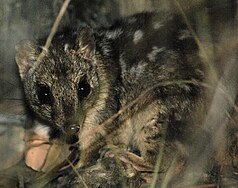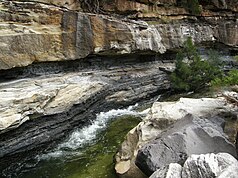Porcupine Gorge National Park
| Porcupine Gorge National Park | ||
|---|---|---|
| The pyramid | ||
|
|
||
| Location: | Queensland , Australia | |
| Specialty: | Canyon, desert landscape | |
| Next city: | 60 kilometer (s) from Hughenden | |
| Surface: | 530 km² | |
| Founding: | 1970 | |
| Visitors: | 15,000 (2011) | |
| Miniature sacred marten ( Dasyurus hallucatus ) | ||
| Letter dove ( Geophaps scripta ) | ||
| cut coal seams | ||
The Porcupine Gorge National Park (English Porcupine Gorge National Park ) is a 54 square kilometer national park in Queensland , Australia .
location
It is located in the North Queensland region , approximately 60 kilometers north of Hughenden and 385 kilometers west of Townsville . Coming from the south on the unpaved Kennedy Developmental Road , a two-kilometer spur road branches off to the Porcupine Gorge viewpoint. Pyramid Campground is 11 kilometers north on Emu Plains Road .
The Blackbraes , White Mountains , Moorrinya and Great Basalt Wall national parks are in the vicinity .
Terrain forms
The park is 25 kilometers long and only a few kilometers wide and follows the course of the Porcupine Creek and includes open forest and grassland on both sides. The river has dug an impressive gorge, an average of 120 meters deep, through hundreds of millions of years old sedimentary rock. In the course of time, erosion created a pyramid in the broad parts of the canyon , a single monolith made of multi-colored layers of sandstone . This formation was only possible because five million years ago a lava flow over the sandstone formed a thin but hard basalt cover layer that protects the soft rock below. At places where this cover layer had been removed, Porcupine Creek could dig itself deep into the sandstone. The deeper sediment layers from the Permian , which are cut in the canyon, belong to the Galilee Basin and contain the coal seams of the Betts Creek Beds. The seams are explored outside of the park for their buildability.
Flora and fauna
During the rainy season Porcupine Creek is a raging brook, in the dry season it is a thin trickle with numerous waterholes that attracts a variety of animals, including those threatened with extinction such as the pygmy marten and the letter pigeon . In total, the park is home to 80 species of birds, 30 species of reptiles and 30 species of mammals. The larger species include mountain kangaroos , red giant kangaroos, and red rat kangaroos . A dingo population is consciously conserved to keep cats short and to regulate the kangaroo population.
The flora is characterized by eucalyptus , acacias , myrtle heather and casuarina , and there are also rarer species such as the Pink Gidgees ( Acacia crombiei ).
Web links
- Official site of the park (English)
Individual evidence
- ↑ Australian Government - CAPAD 2010 ( MS Excel ; 170 kB), DSEWPaC , accessed on January 7, 2013 (English)
- ↑ Australian Government - CAPAD 1997 ( MS Excel ; 93 kB), DSEWPaC , accessed on January 7, 2013 (English)
- ↑ a b c d Porcupine Gorge National Park - Management Plan 2011 , Queensland Parks and Wildlife Service , accessed on October 7, 2012 (pdf, English; 476 kB)
- ↑ a b Official Park Website - About , Queensland Parks and Wildlife Service , accessed October 7, 2012
- ↑ a b Official website of the park - Culture , Queensland Parks and Wildlife Service , accessed October 7, 2012 (English)




